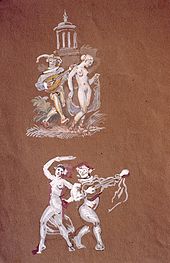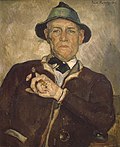Paul Roloff
Paul Alexander Roloff (born January 26, 1877 at Gut Jerchel, Stendal district in Altmark, † May 29, 1951 in Prien am Chiemsee ) was a German painter.
Life
Paul Roloff was born as the youngest of five children of the businessman Adolf Roloff and his second wife Elisabeth.
After graduating from high school , he enrolled at the Munich University of Architecture in 1898 at the request of his father . His teacher, Professor Friedrich Thiersch , the builder of the Munich Palace of Justice, worked with the reluctant father to ensure that Roloff was finally allowed to become a painter as he wished. On November 2, 1898, he was able to enroll in the nature class at the Royal Bavarian Academy of Fine Arts in Munich. His teachers included Karl Raupp , Moritz Weinholdt , Ludwig Schmid-Reutte and Franz von Stuck . He also studied one semester at the Grand Ducal Art School in Karlsruhe with Friedrich Fehr .
Early creative phase (until 1914)
After finishing his studies, the father cut the monthly support. He wanted his son to become financially independent as quickly as possible. This is how, inspired by his painter friends Erich and Rudolf Wilke, his entire graphic work was created. Drawings for the Simplicissimus , the youth and above all the Affenspiegel , whose title page he designed, were created.
Since Munich was the adopted home of Paul Roloff, he did his military service in 1902 in the 1st field artillery regiment "Prince Regent Luitpold" of the Bavarian Army .
In 1905 he moved into a studio in Hohenzollernstrasse with the draftsman Erich Wilke and the sculptor Ulfert Janssen . 50 in Munich-Schwabing. It became a meeting point for a large circle of friends and artists, including Paul Bonatz , Wilhelm Koeppen , Rudolf Wilke , Julius Hess , Rudolf Haus , Rudolf Esterer and Adelbert Niemeyer .
In 1907 Roloff married the Norwegian Aagot Lindeman; the three daughters Berit, Anna and Elisabeth were born in 1908, 1912 and 1915. He moved into a studio apartment at Adalbertstrasse 55. There he temporarily had two studios. He rented one of them to Christian Rohlfs in 1909 .
The years up to 1914 were marked by numerous trips, for example to Norway in 1910 and Denmark in 1913, he spent the summer holidays in Seeon in 1912 and at Lake Chiemsee in 1914 . There he was called up to join his regiment on the Western Front in the First World War . He was wounded several times, and a gunshot through the hip in 1918 troubled him all his life. The family moved to Törwang am Samerberg after their Munich apartment was confiscated . There the eldest daughter died of the Spanish flu in 1918 .
After the First World War - Distress and Recognition (1918 to 1933)
The poor economic situation in the country initially gave him no chance to earn a living for his family by painting. So he bought the Aich farm near Prutting and worked as a farmer. But painting didn't let go of him. In 1921 he sold Aich and bought a house in Stock near Prien am Chiemsee .
There he founded the artist group Die Welle with Bernhard Klinkerfuß , Karl-Hermann Müller-Samerberg , Emil Thoma , Paula von Goeschen-Roesler and Friedrich Lommel . Under the most difficult financial conditions, the association built its own art building on the Stocker archipelago in order to provide enough exhibition opportunities for each member.
Up until the economic crisis in 1929, Roloff received an increasing number of orders from northern Germany for paintings and portraits. He was now recognized and well paid. As a result of the global economic crisis in 1929, there were many cancellations and it wasn't until the mid-30s that things started to improve again.
Creative phase in the Third Reich (1933 to 1945)
His exhibition at the Münchner Kunstverein on the occasion of his 60th birthday with Gabriele Münter and Hans Reinhold Lichtenberger was a great success with excellent reviews ; the upcoming appointment as adjunct professor was postponed until 1939. Roloff was not a member of the NSDAP and remained on the board of the Evangelical Church in Prien.
In 1937 he prepared an expert opinion for the Reich Chamber of Fine Arts against Heinrich Hoffmann , Hitler's personal photographer . For this reason, his exhibition options in the Haus der Kunst were initially canceled and then severely restricted during the war years.
Submitted images were renamed by the jury (for example My Daughter Anna 1931 in Der Feldpostbrief )
After the Second World War (1945 to 1951)
After the war, colors were hard to come by. The Prien house was full of billeted refugees. Roloff had a serious heart condition and his war injury kept bothering him. He died in his home on May 29, 1951.
plant
Until 1914
After Roloff had mainly dealt with landscape and portrait painting during his studies, he suddenly had to earn money. Through his friends Erich and Rudolf Wilke he got in touch with the satirical newspapers of the time. The graphic sheets, which were created primarily for the Affenspiegel (around 1901), already show a mature style; they can compete technically with the graphics of the best German illustrators. Roloff received suggestions from French and English lithographers and the employees of the Simplicissimus who were influenced by them .
Returning to color and oil painting, a new motif came to the fore, the nude. Until 1914 it was shown in ever new variations. From 1904 Roloff exhibited regularly at the Secession , of which he became a member in 1911. Through these pictures he became known to the public and critics. The interior played a compositionally not unimportant role and the
Models appeared with an unfamiliar naturalness and ease - they should not provoke.
At the same time, Roloff also drew attention to himself with religious images. As early as 1907/08 he made designs for the painting of the Villa Berolzheimer on Lake Baader near Garmisch with motifs from the Old Testament. Among the religious representations are the most expressive paintings by Roloff. It is understandable that the combination of Christian themes with female nudes earned Roloff not only praise but also sharp criticism.
They have been happy and successful years. During the summer stays in Wolfratshausen and Seeon , many landscape pictures were created. But the trips to Norway (1910) and Denmark (1913) had a much stronger influence on his painting. The constantly changing moods over the sea attracted him. The clear Nordic light brightened his palette. Water and clouds did not let go of him even later on the Adriatic Sea and the Chiemsee.
1914 to 1933
He was torn from this creative time when he was drafted into the First World War. He was almost unable to paint for six years, a huge turning point. The new beginning was difficult. Influenced by the experiences of the war and committed to caring for his family, he threw himself into work. The founding of the wave and membership in the Secession opened up the opportunity to become known again.
From 1923 he received increasing orders from northern Germany, mainly portraits and paintings in representative rooms. The works for the pavilion of the Münchner Illustrierte at the international press exhibition Pressa in Cologne in 1928 and the painting of the garden pavilions of Herrenhausen Palace in Hanover in 1938/39 were probably the most interesting. These orders gave him a lot of creative freedom. Portrait painting required considerably more concentration. For him, resemblance was just the basic requirement for a good portrait. It was important to him to capture the essence and charisma of what was depicted. One critic assessed the result as follows: "(Roloff) is able to grasp the individual in its core and unique essence sharply psychologically and to present what has been captured in a typical and witty manner."
Over 140 portraits were created in the period up to the Second World War . Paintings and landscapes were added.
1933 to 1951
In the war years there were only about 40 portraits, nine of which were portraits of fallen soldiers, which he painted in uniform based on photos on behalf of his parents . It was these pictures that the jury of the major exhibitions mostly chose - because of the uniform. His exhibition options were severely limited after the expert opinion against Hoffmann and the fact that he was not a party member.
After the war, the situation hardly got any better. There were hardly any orders or colors. He had a serious heart condition and the work was extremely strenuous. He died on May 29, 1951.
Works (selection)
Landscapes
- Prien am Chiemsee 1931 Market Prien
- Chiemseelandschaft 1932 Bavarian State Painting Collections
Portraits
- Hannah von Gosen 1933 Bavarian State Painting Collections,
- Chrysille Janssen 1935 Lenbachgalerie Munich,
- Erich Wilke 1935 Städt. Gallery Braunschweig,
- Prof. Oswald Bieber 1936 Lenbach Gallery Munich,
- Prof. Johann Viertaler 1936 Ludwig Hack Museum Ludwigshafen,
- Prof. Paul Ludwig Troost 1936 US Army Center of Military History Washington,
- Prof. Franz Naager 1937 Secession Gallery Munich,
- Prof. Rudolf Sieck 1939 Municipal Gallery Rosenheim.
Literature (selection)
- Roloff, Paul . In: Hans Vollmer (Hrsg.): General lexicon of fine artists from antiquity to the present . Founded by Ulrich Thieme and Felix Becker . tape 28 : Ramsden-Rosa . EA Seemann, Leipzig 1934, p. 539 .
- Paul Roloff . In: Hans Vollmer (Hrsg.): General Lexicon of Fine Artists of the XX. Century. tape 4 : Q-U . EA Seemann, Leipzig 1958, p. 92 .
- Hans Heyn: South German painting from the Bavarian highlands - the Inntal, Chiemgau and Berchtesgadener Land in visual evidence (= Rosenheim rarities ). Rosenheimer Verlagshaus, Rosenheim 1980, ISBN 3-475-52290-X , p. 146 .
- Horst Ludwig: Münchner Maler im 19. Jahrhundert (= Bruckmanns Lexikon der Münchner Maler 19./20. Century . Volume 6 : Landschreiber – Zintl). Bruckmann, Munich 1994, ISBN 3-7654-1633-9 , pp. 235 ff .
- Fritz Aigner: Gallery in the Old Town Hall, Prien a. Chiemsee: Memorial exhibition on the occasion of the 110th birthday; Paul Roloff, 1877–1951 . Prien a. Chiemsee 1987 (exhibition catalog).
- Special exhibition Paul Roloff: 1877–1951: in the old vicar house on Fraueninsel . Frauenchiemsee 1996 (exhibition catalog).
- Ruth Negendanck: Chiemsee artist landscape . Verlag Atelier im Bauernhaus, Fischerhude 2008, ISBN 978-3-88132-286-7 , p. 132 ff .
swell
- Archive of the artist
- Gabriele Waldmann: Roloff Paul. (Biography, gailerfineartchiemsee.de )
Individual evidence
- ↑ 1941 Paul Roloff. In: Matriculation Book 3 (1884–1920). Matriculation database - Academy of Fine Arts Munich, accessed on October 2, 2019 .
| personal data | |
|---|---|
| SURNAME | Roloff, Paul |
| ALTERNATIVE NAMES | Roloff, Paul Alexander (full name) |
| BRIEF DESCRIPTION | German painter |
| DATE OF BIRTH | January 26, 1877 |
| PLACE OF BIRTH | Gut Jerchel, Stendal Altmark district |
| DATE OF DEATH | May 29, 1951 |
| Place of death | Prien am Chiemsee |











